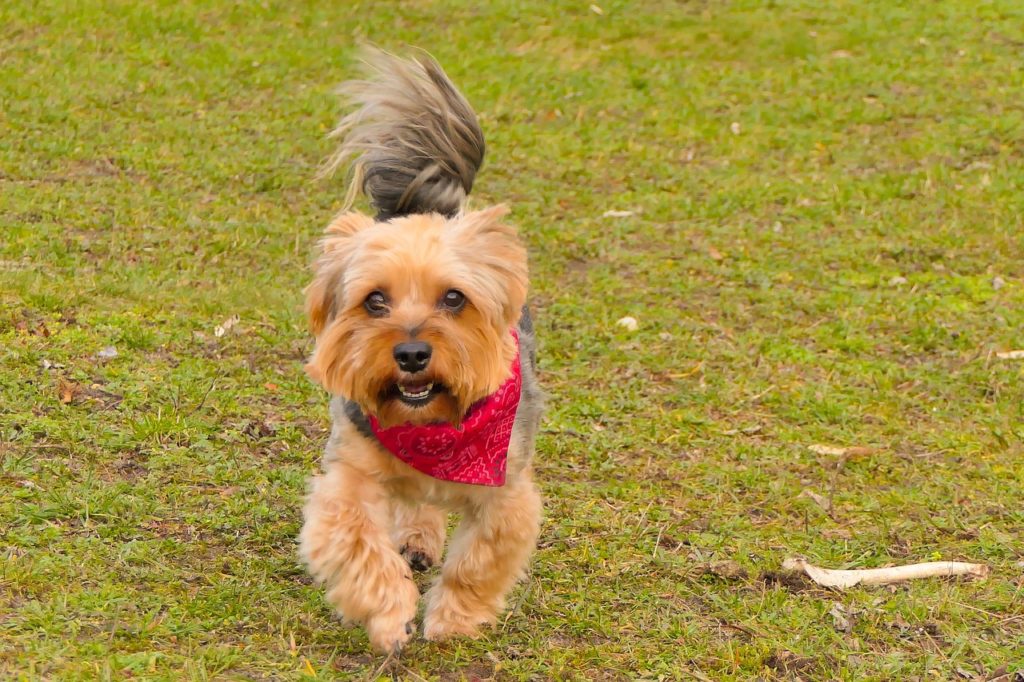
Beyond Wagging: Unraveling the Canine Communication in Dog Tails
Dogs are exceptional communicators, and one of the most expressive parts of their anatomy is their dog tail.
Beyond the familiar wag, various tail movements convey a spectrum of emotions.
In this blog post, we’ll delve into the intriguing world of dog tail language, exploring eight distinct movements and their meanings.
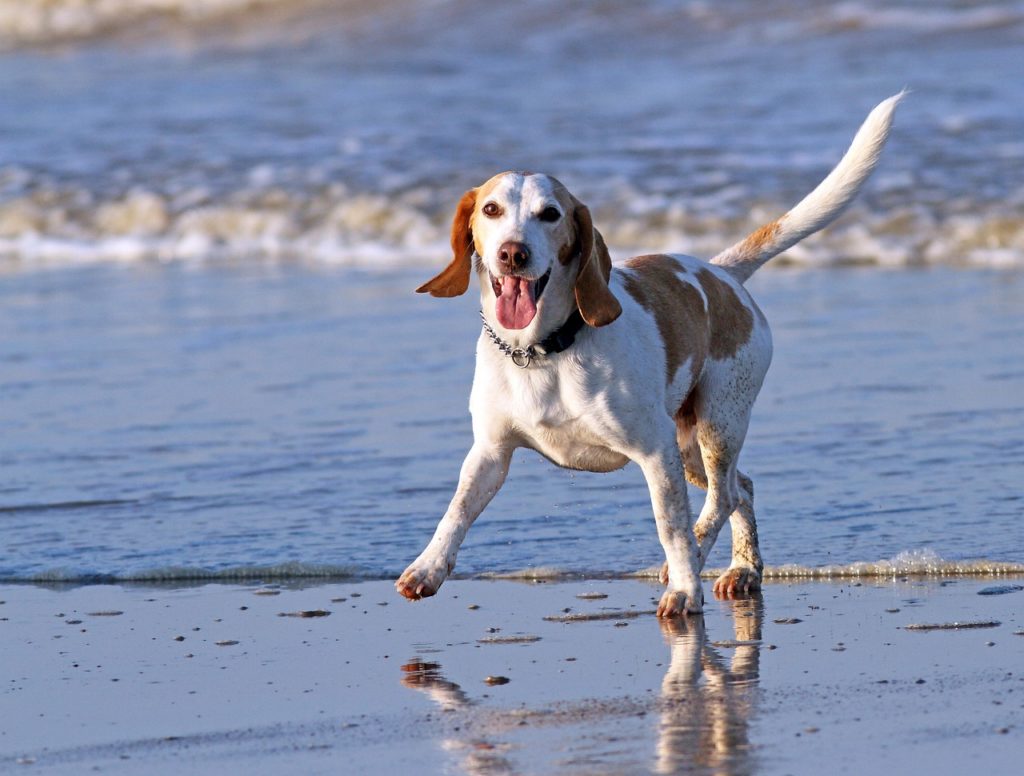
Flagpole Dog Tail: Confidence and Alertness
The Flagpole Tail is a distinctive canine communication signal that speaks volumes about a dog’s emotional state.
When a dog holds its tail high and straight, resembling a flagpole standing tall, it is conveying a message of confidence and alertness.
What a Flagpole Dog Tail Indicates:
1. Confidence:
- A flagpole tail signifies a confident and assertive demeanor. Your dog is feeling secure and in control of its surroundings.
2. Alertness:
- The elevated tail position reflects a heightened state of alertness. The dog is keenly observing its environment, ready to respond to any changes or stimuli.
3. Positive Engagement:
- Dogs with a flagpole tail may be expressing positive engagement with their surroundings. This could be during playtime, exploration, or when meeting new people or animals.
Considerations for a Flagpole Tail:
- Breed-Specific Variations:
- Keep in mind that certain breeds naturally carry their tails high. While a flagpole tail may generally indicate confidence, it’s essential to consider breed-specific traits and individual variations.
- Keep in mind that certain breeds naturally carry their tails high. While a flagpole tail may generally indicate confidence, it’s essential to consider breed-specific traits and individual variations.
- Context Matters:
- Always pay attention to the context in which the flagpole tail is displayed. If the tail is accompanied by other signs of aggression or discomfort, it may indicate a different emotional state.
How to Respond to a Flagpole Dog Tail:
- Positive Reinforcement:
- Reinforce positive behavior by praising your dog when it displays a flagpole tail during positive interactions or situations.
- Reinforce positive behavior by praising your dog when it displays a flagpole tail during positive interactions or situations.
- Observe Overall Body Language:
- While the flagpole tail is a significant indicator, consider your dog’s overall body language to gain a comprehensive understanding of its emotions.
Conclusion of a Flagpole Dog Tail:
In conclusion, the Flagpole Tail is a fascinating aspect of canine communication.
By recognizing and understanding this tail position, you can better connect with your dog and respond appropriately to its emotional needs.
Embrace the confidence and alertness your dog expresses through its tail, and continue fostering a strong and positive relationship.
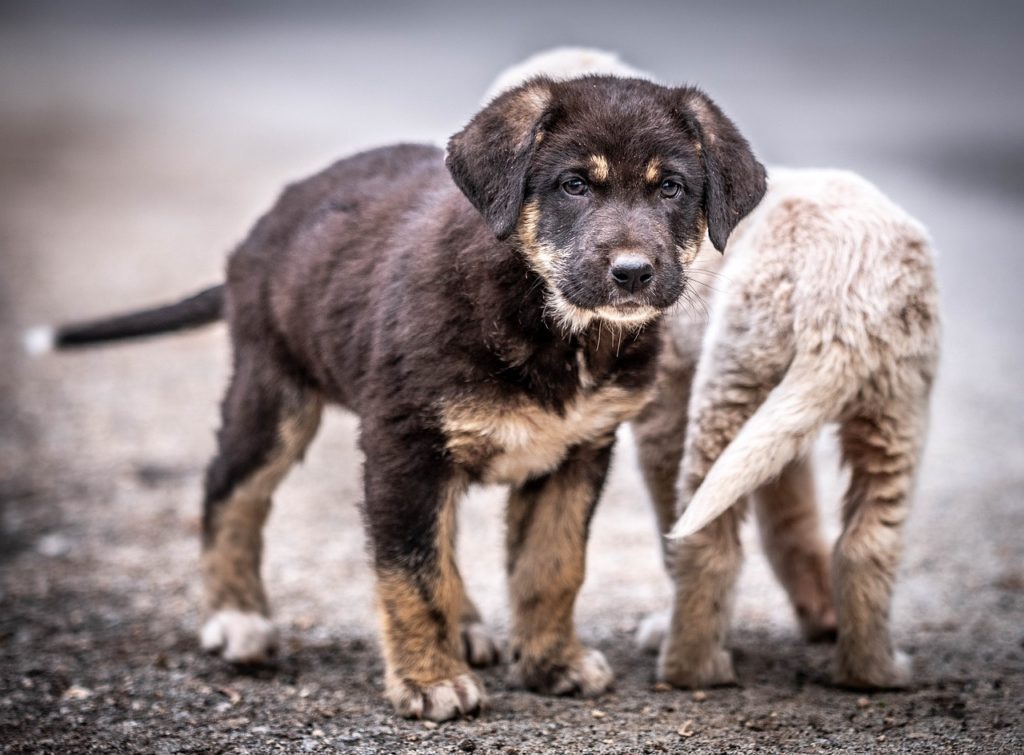
Swaying Dog Tail: Contentment and Relaxation
The Swaying Tail is a gentle and rhythmic movement that holds valuable insights into a dog’s emotional state.
When a dog’s tail moves gracefully from side to side, it is often a positive indicator of contentment and relaxation.
Understanding the nuances of this tail movement can deepen your connection with your furry friend.
Characteristics of a Swaying Dog Tail:
- Side-to-Side Motion:
- The tail moves horizontally in a relaxed, rhythmic swaying motion, creating a gentle pendulum effect.
- The tail moves horizontally in a relaxed, rhythmic swaying motion, creating a gentle pendulum effect.
- Moderate Pace:
- Unlike a rapid wag associated with excitement, the sway is characterized by a moderate and steady pace.
What a Swaying Tail Indicates:
1. Contentment:
- A swaying tail is a telltale sign of contentment and a positive emotional state. Your dog is comfortable, happy, and enjoying the current moment.
2. Relaxation:
- This tail movement often occurs when a dog is in a relaxed state. Whether lounging at home or during calm outdoor activities, the sway suggests a lack of tension or stress.
3. Social Comfort:
- Dogs may display a swaying tail when in the company of familiar humans or other dogs, indicating a sense of social comfort and security.
Considerations for a Swaying Tail:
- Breed-Specific Characteristics:
- Some breeds naturally carry their tails in a swaying or wagging manner. Be aware of your dog’s breed-specific traits to better understand its typical tail behavior.
- Some breeds naturally carry their tails in a swaying or wagging manner. Be aware of your dog’s breed-specific traits to better understand its typical tail behavior.
- Contextual Awareness:
- While a swaying tail is generally a positive sign, consider the overall context. If other body language suggests discomfort or anxiety, additional attention may be needed.
How to Respond to a Swaying Dog Tail:
- Positive Reinforcement:
- Reinforce the positive behavior by offering praise, affection, or treats when your dog displays a swaying tail, especially during moments of bonding.
- Reinforce the positive behavior by offering praise, affection, or treats when your dog displays a swaying tail, especially during moments of bonding.
- Encourage Relaxation:
- Create an environment that promotes relaxation, providing a comfortable space and engaging in activities that your dog enjoys.
Conclusion to a Swaying Dog Tail:
Recognizing the significance of a swaying tail allows you to connect with your dog on a deeper level.
By understanding when your dog is content and relaxed, you can nurture a positive and supportive relationship.
Embrace these moments of calmness and remember that a swaying tail often speaks volumes about the happiness and well-being of your cherished canine companion.
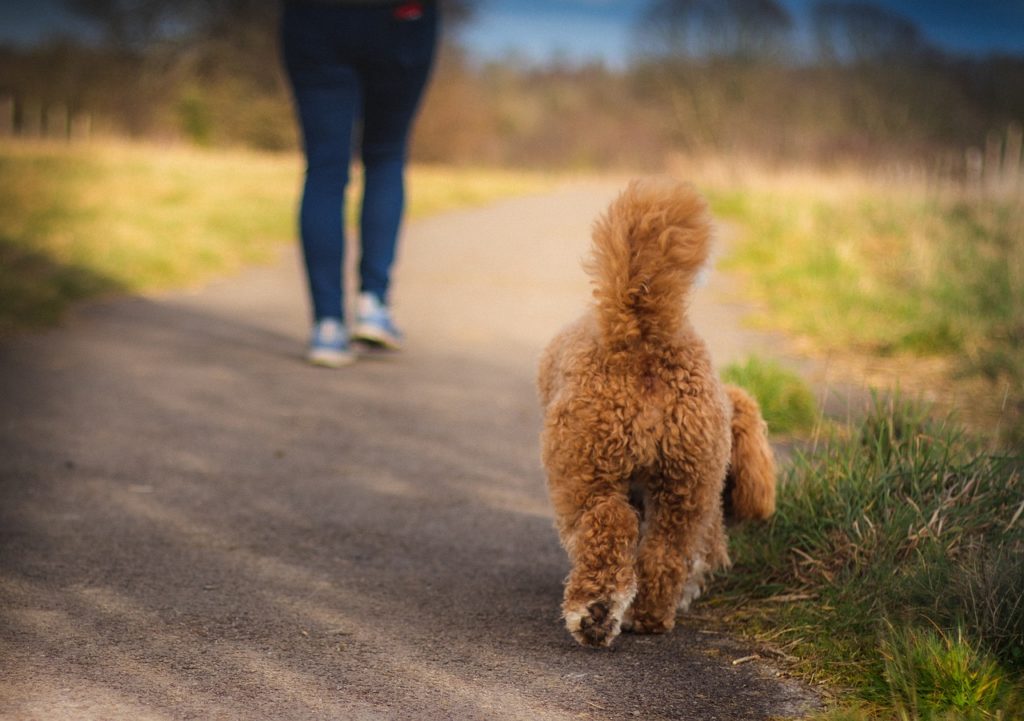
Helicopter Dog Tail: Overwhelming Excitement
The Helicopter Tail is an exuberant and joyous display of canine enthusiasm that brings a smile to any dog owner’s face.
This unique tail movement resembles the circular motion of a helicopter propeller and is a clear indication of overwhelming excitement and happiness.
Characteristics of a Helicopter Tail:
- Circular Wagging:
- The tail moves in a circular or semi-circular motion, creating a distinctive and animated pattern.
- The tail moves in a circular or semi-circular motion, creating a distinctive and animated pattern.
- Whole Body Wiggles:
- Often accompanied by a wagging body, the Helicopter Tail involves not just the tail but the entire hind end of the dog, showcasing uncontainable excitement.
What a Helicopter Tail Indicates:
1. Pure Joy:
- A Helicopter Tail is a sure sign of unbridled joy and exuberance. Your dog is thrilled, and the tail’s circular motion reflects the sheer happiness it feels.
2. Expression of Excitement:
- This tail movement commonly occurs during moments of excitement, such as greeting you after a long day or anticipating a favorite activity.
3. Playfulness:
- Dogs often exhibit the Helicopter Tail during playtime, signaling their playful and energetic mood.
Considerations for a Helicopter Dog Tail:
- Context Matters:
- While the Helicopter Tail is generally associated with positive emotions, always consider the context. In some situations, it may be a response to heightened stimuli or anticipation.
- While the Helicopter Tail is generally associated with positive emotions, always consider the context. In some situations, it may be a response to heightened stimuli or anticipation.
- Individual Variation:
- Dogs have unique personalities, and the intensity of the Helicopter Tail may vary between individuals. Some may display a subtle version, while others go all out with exuberant twirls.
How to Respond to a Helicopter Tail:
- Join the Celebration:
- Embrace the joy and excitement by engaging in playful activities with your dog. Whether it’s a game of fetch or a simple belly rub, participate in the celebration.
- Embrace the joy and excitement by engaging in playful activities with your dog. Whether it’s a game of fetch or a simple belly rub, participate in the celebration.
- Positive Reinforcement:
- Reinforce the positive behavior by offering praise, treats, or affection. This encourages your dog to associate the Helicopter Tail with positive experiences.
Conclusion of a Helicopter Dog Tail:
The Helicopter Tail is a heartwarming expression of your dog’s happiness and enthusiasm.
By recognizing and celebrating these moments, you strengthen the bond with your furry friend.
Enjoy the delightful spectacle of the Helicopter Tail, and let it serve as a reminder of the pure, unfiltered joy that dogs bring into our lives.
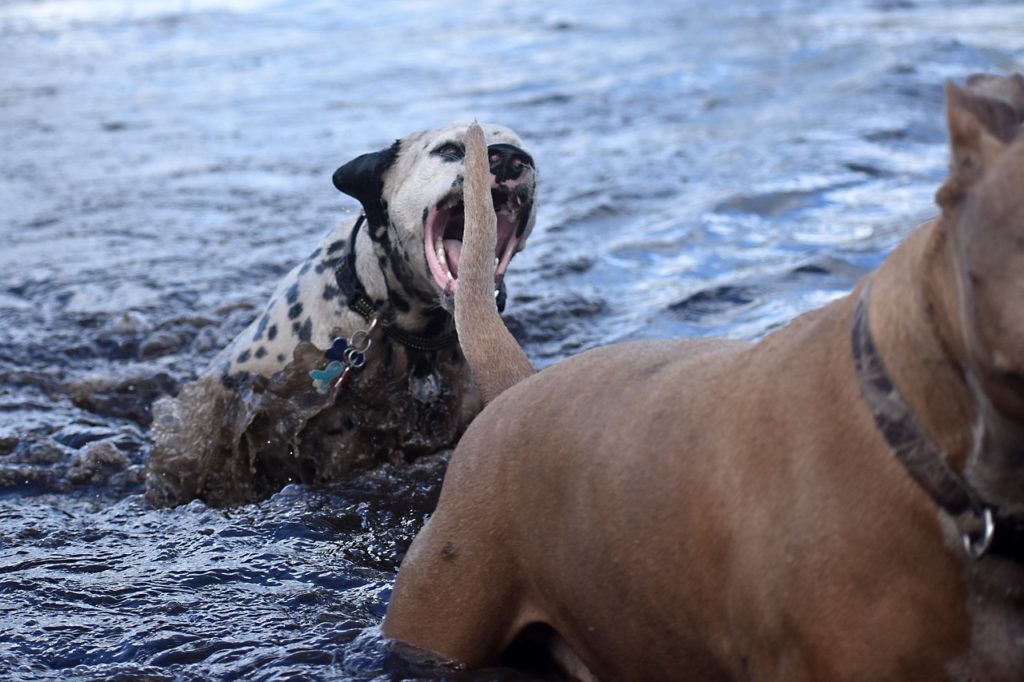
Whale Eye with Dog Tail Wag: Nervousness or Fear
The Whale Eye with Tail Wag is a unique combination of body language that conveys a nuanced message about a dog’s emotions.
Recognizing the subtle cues in both the eyes and tail can offer valuable insights into your dog’s state of mind, particularly when it comes to feelings of nervousness or fear.
Characteristics of Whale Eye with Dog Tail Wag:
- Whale Eye Expression:
- The “whale eye” occurs when a dog turns its head away from a perceived threat but keeps an eye on it. The whites of the eye become visible, creating a distinctive look.
- The “whale eye” occurs when a dog turns its head away from a perceived threat but keeps an eye on it. The whites of the eye become visible, creating a distinctive look.
- Accompanied by Tail Wag:
- Despite the nervous expression, the dog may simultaneously wag its tail. This seemingly contradictory behavior can be confusing but reflects a complex emotional state.
What Whale Eye with Tail Wag Indicates:
1. Nervousness or Fear:
- The whale eye indicates a level of unease or fear, suggesting that your dog perceives a situation as potentially threatening or uncomfortable.
2. Submissive Gesture:
- The wagging tail, in this case, is often a submissive gesture, indicating a desire to appease or avoid conflict.
3. Mixed Emotions:
- The combination of a wagging tail and whale eye demonstrates a conflict between the dog’s desire to engage positively and its apprehension or fear of a particular stimulus.
Considerations for a Whale Eye with Tail Wag:
- Identify the Trigger:
- Pay attention to the environment and identify potential triggers that might be causing your dog’s nervousness. It could be a new person, another animal, or a specific situation.
- Pay attention to the environment and identify potential triggers that might be causing your dog’s nervousness. It could be a new person, another animal, or a specific situation.
- Provide Reassurance:
- Offer calm and reassuring signals to your dog. Avoid forcing interaction and allow your pet to approach or retreat as needed.
How to Respond to a Whale Eye with Dog Tail Wag:
- Create a Positive Environment:
- Gradually expose your dog to the perceived threat in a controlled and positive manner. This can help desensitize them over time.
- Gradually expose your dog to the perceived threat in a controlled and positive manner. This can help desensitize them over time.
- Avoid Punishment:
- Never punish a dog displaying the whale eye with a wagging tail. This behavior indicates discomfort, and punishment can exacerbate feelings of fear and anxiety.
Conclusion for a Whale Eye with Tail Wag:
Understanding the complex interplay between a whale eye and a tail wag provides a glimpse into the intricate world of canine communication.
By acknowledging and respecting your dog’s mixed emotions, you can create an environment that fosters trust and helps alleviate feelings of nervousness or fear.
Pay attention to the context, be patient, and work towards building a sense of security for your furry friend.
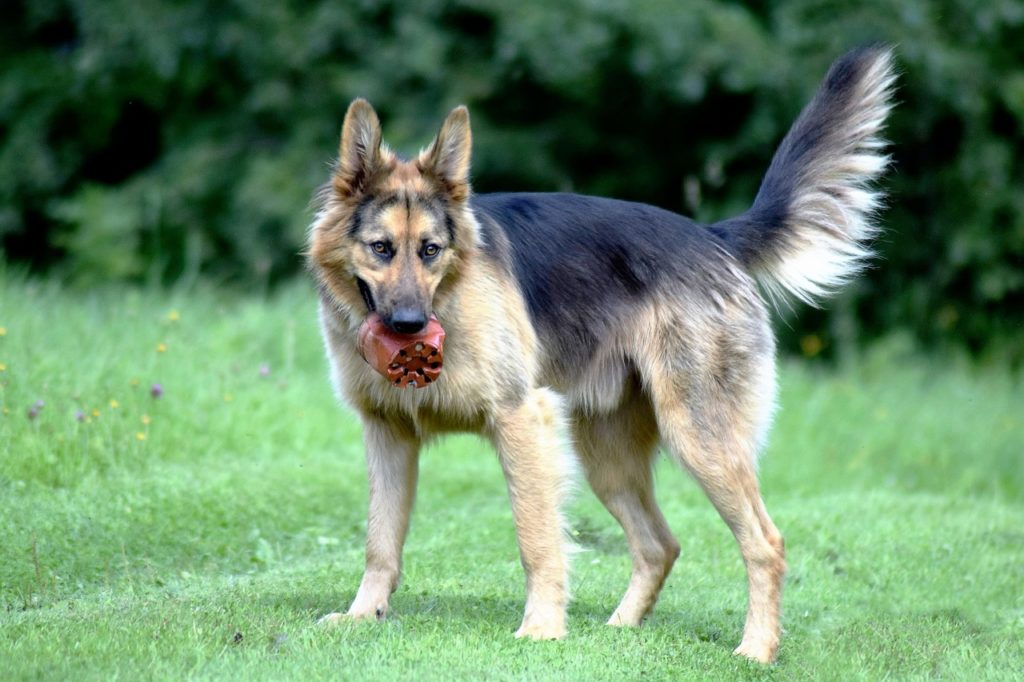
Stiffly Raised Dog Tail: Alertness or Potential Aggression
The Stiffly Raised Tail is a posture that can convey a range of emotions in dogs, often signaling a heightened state of alertness or potential aggression.
This tail position, where the tail is raised and held stiffly, provides valuable information about a dog’s current emotional and psychological state.
Characteristics of a Stiffly Raised Dog Tail:
- Elevated Position:
- The tail is raised higher than usual, indicating increased arousal and alertness.
- The tail is raised higher than usual, indicating increased arousal and alertness.
- Stiff Posture:
- Unlike a loose and relaxed tail, a stiffly raised tail is held rigidly, reflecting a tenser and more focused demeanor.
What a Stiffly Raised Tail Indicates:
1. Alertness:
- The raised tail signals a heightened level of alertness. Your dog is acutely aware of its surroundings and is actively assessing the situation.
2. Potential Aggression:
- In some cases, a stiffly raised tail can be a warning sign of potential aggression. The dog may feel threatened or perceive a challenge, leading to a defensive posture.
3. Defensive Posture:
- Dogs may adopt a stiffly raised tail as a defensive mechanism, preparing to react to perceived threats. This can be a response to unfamiliar people, animals, or situations.
Considerations for a Stiffly Raised Tail:
- Body Language Context:
- It’s crucial to observe the overall body language of the dog. Factors such as ear position, facial expressions, and overall posture can provide additional insights into the dog’s emotional state.
- It’s crucial to observe the overall body language of the dog. Factors such as ear position, facial expressions, and overall posture can provide additional insights into the dog’s emotional state.
- Individual Variations:
- Different dogs may exhibit variations in their response to heightened alertness. Some breeds naturally carry their tails higher, so understanding your dog’s breed-specific behavior is essential.
How to Respond to a Stiffly Raised Tail:
- Maintain Calmness:
- If your dog displays a stiffly raised tail, it’s essential to remain calm. Avoid sudden movements or loud noises that may escalate tension.
- If your dog displays a stiffly raised tail, it’s essential to remain calm. Avoid sudden movements or loud noises that may escalate tension.
- Assess the Environment:
- Identify potential triggers or stressors in the environment that may be causing the dog’s heightened alertness. Removing or addressing these factors can help calm the situation.
Conclusion of a Stiffly Raised Tail:
While a stiffly raised tail can indicate alertness and potential aggression, it’s essential to approach the situation with caution and understanding.
Observing your dog’s body language and responding appropriately can help diffuse tension and prevent escalating stress.
By recognizing and respecting your dog’s signals, you contribute to a positive and safe environment for both your pet and those around them.
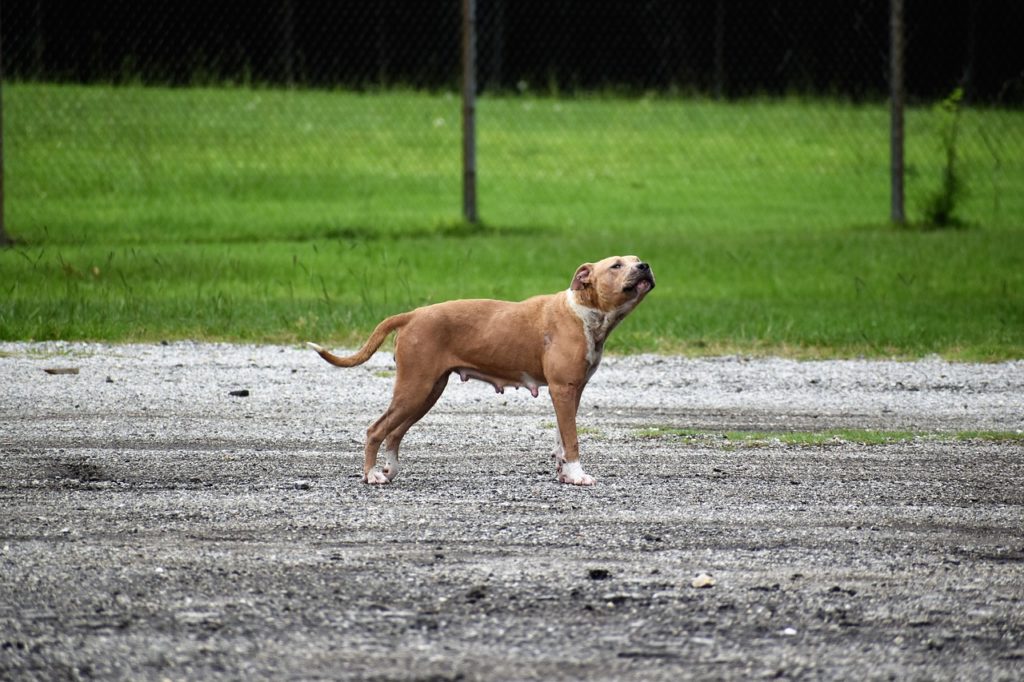
Slow Wag with Low Dog Tail: Submissive or Uncertain
The Slow Wag with Low Tail is a canine body language that communicates a range of emotions, often linked to feelings of submission, uncertainty, or appeasement.
Understanding this tail movement can provide insights into your dog’s emotional state and help you respond appropriately to their needs.
Characteristics of Slow Wag with Low Tail:
- Slow Wagging Motion:
- The tail moves in a deliberate and unhurried manner, indicating a subdued level of excitement compared to faster wags.
- The tail moves in a deliberate and unhurried manner, indicating a subdued level of excitement compared to faster wags.
- Low-Held Tail:
- The tail is positioned lower than usual, sometimes tucked between the hind legs. This lowered position reflects a submissive or uncertain stance.
What Slow Wag with Low Dog Tail Indicates:
1. Submission:
- The slow wag with a low tail is often associated with submission. Your dog may be expressing deference or acknowledgment of a perceived higher status.
2. Uncertainty or Anxiety:
- This tail movement can also indicate feelings of uncertainty or anxiety. Your dog may be unsure about a situation or feeling mildly stressed.
3. Appeasement Behavior:
- Dogs may use the slow wag with a low tail as a form of appeasement, attempting to communicate non-threatening intentions to other dogs or humans.
Considerations for Slow Wag with Low Tail:
- Body Language Ensemble:
- Always consider the overall body language of your dog. Combining a slow wag with a low tail with other cues, such as crouching or avoiding eye contact, provides a more complete picture.
- Always consider the overall body language of your dog. Combining a slow wag with a low tail with other cues, such as crouching or avoiding eye contact, provides a more complete picture.
- Individual Personality:
- Dogs have unique personalities, and some may naturally display a slow wag with a low tail as part of their normal behavior. Understanding your dog’s baseline behavior is crucial for accurate interpretation.
How to Respond to Slow Wag with Low Dog Tail:
- Provide Reassurance:
- If your dog exhibits a slow wag with a low tail in response to a specific situation, offer gentle reassurance and create a calm environment.
- If your dog exhibits a slow wag with a low tail in response to a specific situation, offer gentle reassurance and create a calm environment.
- Avoid Overstimulation:
- Recognize when your dog may be feeling uncertain or anxious and avoid overstimulating situations. Gradually expose them to new experiences in a controlled and positive manner.
Conclusion of Slow Wag with Low Tail:
Interpreting the slow wag with a low tail allows you to connect with your dog on a deeper level.
Whether your furry friend is expressing submission, uncertainty, or appeasement, responding with patience and understanding contributes to a harmonious relationship.
By acknowledging and respecting your dog’s emotional cues, you build trust and create an environment where your pet feels secure and valued.

Rapid Dog Tail Tapping: Excitement or Anticipation
Rapid Tail Tapping is an animated and energetic tail movement that communicates a high level of excitement or anticipation in dogs.
This behavior, characterized by the tail rapidly tapping on the ground or against a surface, is a clear expression of positive emotions and eagerness.
Characteristics of Rapid Tail Tapping:
- Quick and Repetitive Motion:
- The tail moves rapidly, often tapping on the floor or against nearby objects in a brisk and rhythmic manner.
- The tail moves rapidly, often tapping on the floor or against nearby objects in a brisk and rhythmic manner.
- Upbeat Energy:
- The overall body language is infused with energy and enthusiasm, reflecting a heightened state of excitement.
What Rapid Tail Tapping Indicates:
1. Excitement:
- Rapid tail tapping is a reliable indicator of excitement. Your dog is thrilled about something and is expressing this enthusiasm through the animated movement of its tail.
2. Anticipation:
- This behavior can also signify anticipation. Your dog is eagerly awaiting a positive event, such as mealtime, play, or a walk.
3. Positive Engagement:
- Dogs may engage in rapid tail tapping when interacting with their favorite humans or other animals, showcasing a positive and social demeanor.
Considerations for Rapid Tail Tapping:
- Contextual Relevance:
- While rapid tail tapping is generally associated with positive emotions, be mindful of the context. Ensure that there are no stressors or negative stimuli contributing to the behavior.
- While rapid tail tapping is generally associated with positive emotions, be mindful of the context. Ensure that there are no stressors or negative stimuli contributing to the behavior.
- Individual Variation:
- Dogs vary in their levels of excitement and how they express it. Some may exhibit a more exuberant tail tap, while others may have a subtler response.
How to Respond to Rapid Tail Tapping:
- Join in the Excitement:
- Acknowledge your dog’s enthusiasm and join in the excitement. Engage in play, offer treats, or initiate activities that contribute to the positive energy.
- Acknowledge your dog’s enthusiasm and join in the excitement. Engage in play, offer treats, or initiate activities that contribute to the positive energy.
- Positive Reinforcement:
- Reinforce the positive behavior by offering verbal praise, affection, or treats. This encourages your dog to associate the rapid tail tapping with rewarding experiences.
Conclusion of Rapid Tail Tapping:
Rapid Tail Tapping is a delightful aspect of canine communication that reflects your dog’s joy and anticipation.
By recognizing and embracing these moments of exuberance, you strengthen the bond with your furry friend.
Responding positively to the rapid tail tapping contributes to a happy and fulfilling relationship, creating an environment where your dog feels valued and understood.
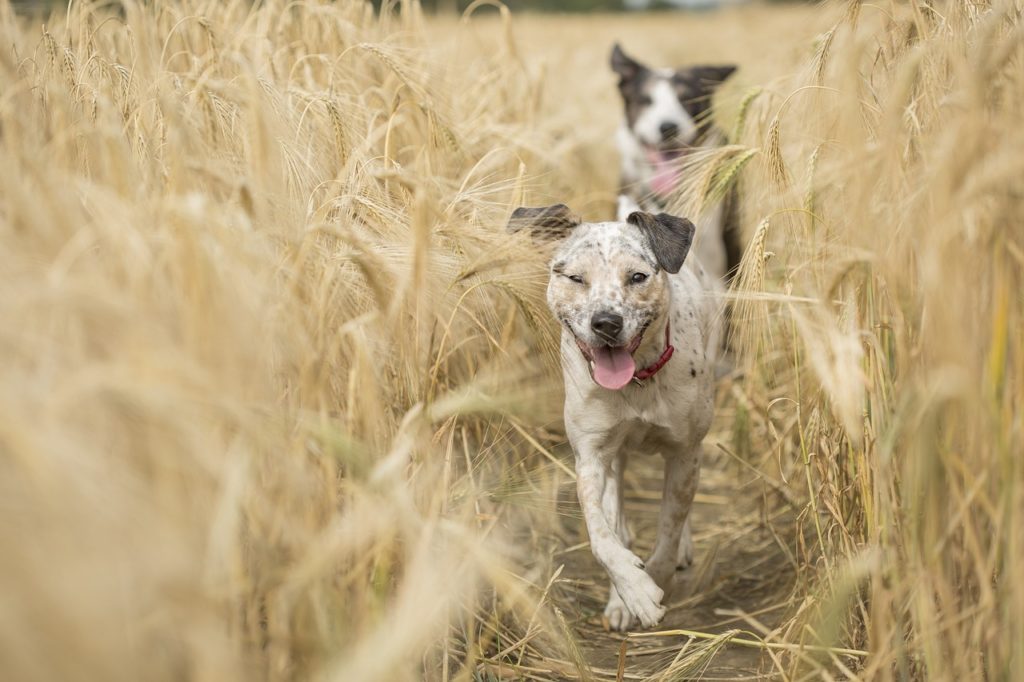
Tail Quivering: Extreme Excitement
Tail quivering is a fascinating behavior that can indicate a range of emotions in dogs. This unique tail movement involves a slight or rapid trembling of the tail, and understanding its context is essential for interpreting your dog’s feelings accurately.
Characteristics of Dog Tail Quivering:
- Vibrating Motion:
- The tail displays a noticeable quivering or trembling motion, ranging from subtle shivers to more pronounced vibrations.
- The tail displays a noticeable quivering or trembling motion, ranging from subtle shivers to more pronounced vibrations.
- Variable Speed:
- Tail quivering can occur at different speeds, from a slow, rhythmic tremor to a rapid, almost vibrating movement.
What Dog Tail Quivering Indicates:
1. Extreme Excitement:
- In some cases, tail quivering can signify extreme excitement. This may occur when a dog is anticipating a highly enjoyable activity, such as mealtime or play.
2. Anticipation or Eagerness:
- Dogs may quiver their tails in anticipation, expressing eagerness for a positive event or interaction.
3. Stress or Anxiety:
- On the other hand, tail quivering can also be a response to stress or anxiety. It may indicate that your dog is feeling uneasy or nervous in a particular situation.
Considerations of Tail Quivering:
- Overall Body Language:
- Evaluate your dog’s overall body language. If tail quivering is accompanied by other signs of excitement, it is likely positive. However, if it coexists with cowering or avoidance behaviors, stress or anxiety may be more probable.
- Evaluate your dog’s overall body language. If tail quivering is accompanied by other signs of excitement, it is likely positive. However, if it coexists with cowering or avoidance behaviors, stress or anxiety may be more probable.
- Individual Variation:
- Dogs vary in how they express emotions. Some dogs may quiver their tails more noticeably than others, even in normal, everyday situations.
How to Respond to Tail Quivering:
- Positive Reinforcement:
- If tail quivering is associated with positive emotions, reinforce this behavior by providing praise, treats, or engaging in the anticipated activity.
- If tail quivering is associated with positive emotions, reinforce this behavior by providing praise, treats, or engaging in the anticipated activity.
- Offer Comfort:
- If tail quivering seems to be related to stress or anxiety, offer comfort and a calm environment. Identify and address potential stressors to help your dog feel more secure.
Conclusion of Dog Tail Quivering:
Tail quivering is a unique and individualized aspect of canine communication.
By paying attention to the context and your dog’s overall demeanor, you can gain valuable insights into their emotional state.
Whether it signifies extreme excitement or stress, responding appropriately enhances your ability to communicate effectively with your furry companion and nurture a positive, trusting relationship.
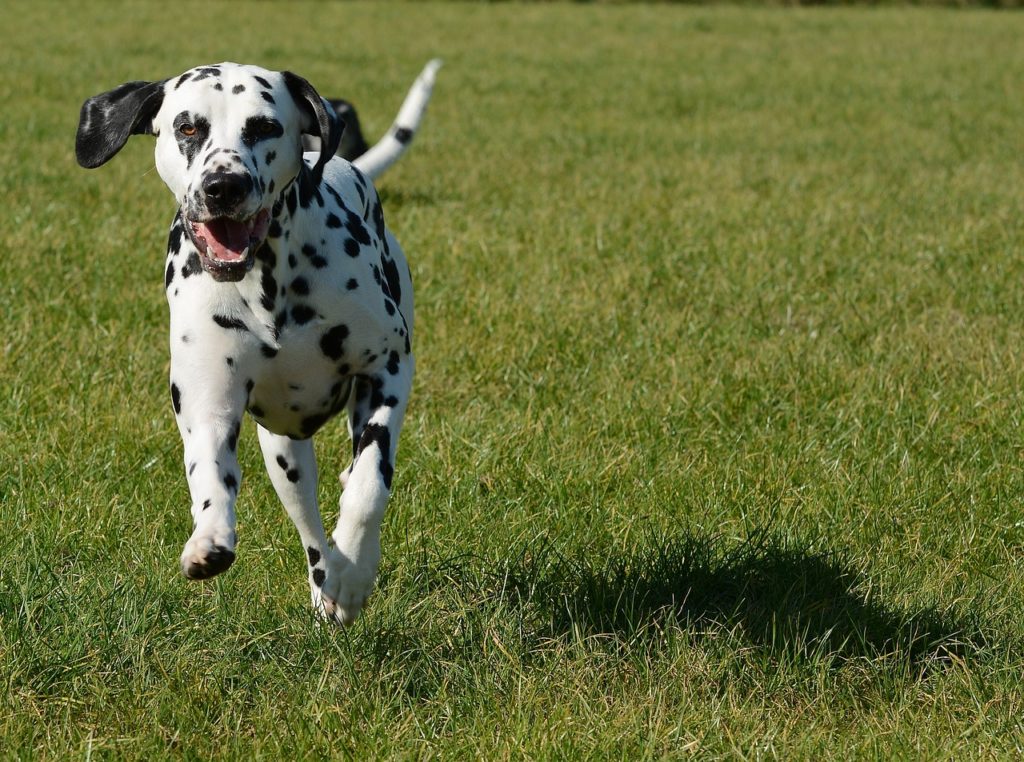
Conclusion of Beyond Wagging Dog Tails
Understanding your dog’s tail language goes beyond simply recognizing a wag.
By paying attention to these eight distinct tail movements, you can gain deeper insights into your furry friend’s emotions and intentions.
Remember that individual variations and breed-specific traits play a role, so always consider the context and observe your dog’s overall body language for a more accurate interpretation.
Strengthen your bond with your canine companion by becoming fluent in the fascinating language of tails.

